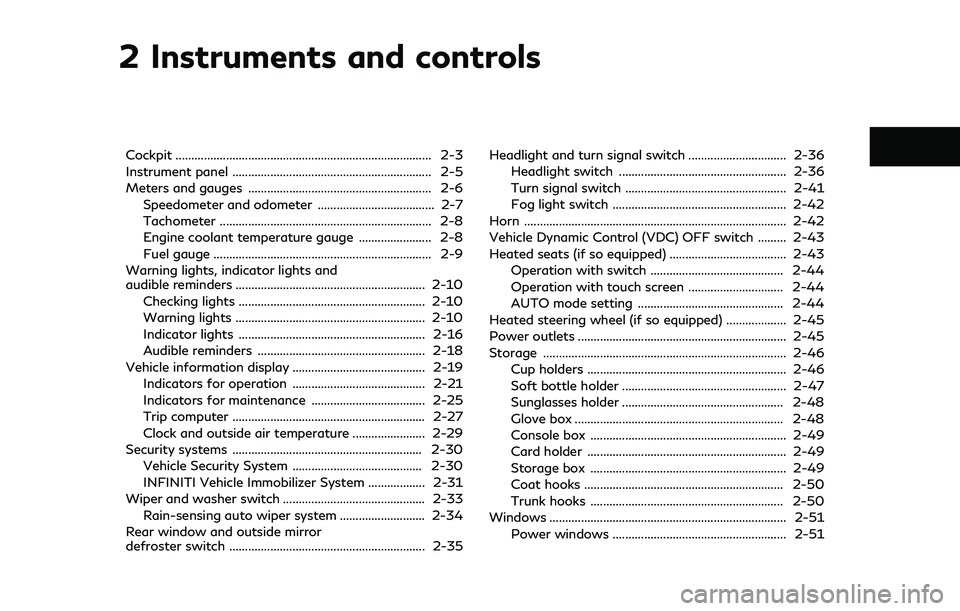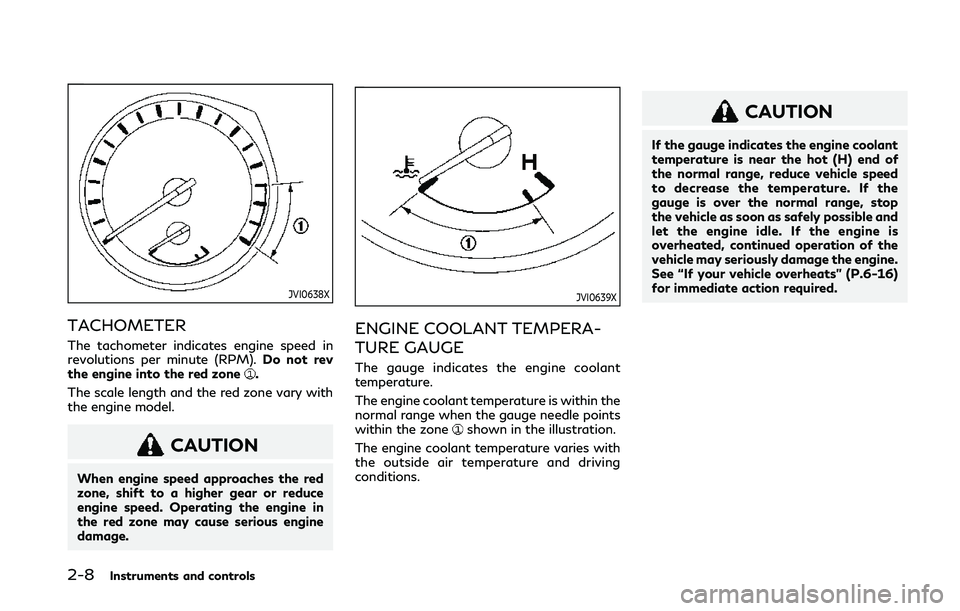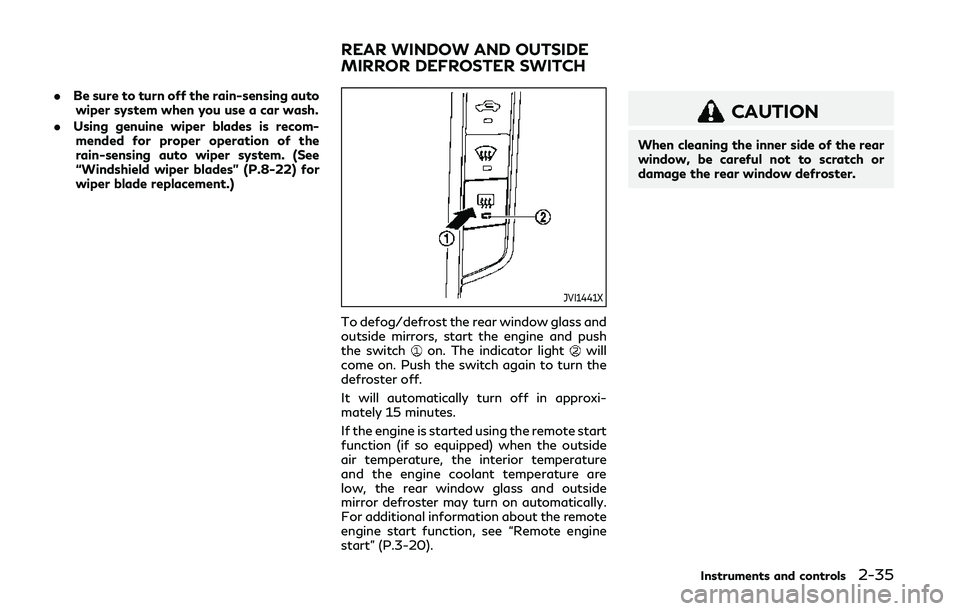coolant temperature INFINITI Q50 2019 Owners Manual
[x] Cancel search | Manufacturer: INFINITI, Model Year: 2019, Model line: Q50, Model: INFINITI Q50 2019Pages: 468, PDF Size: 2.15 MB
Page 17 of 468

JVC0428X
1. Tachometer (P.2-8)
2. Warning and indicator lights (P.2-10)
3. Speedometer (P.2-7)
4. Engine coolant temperature gauge(P.2-8) 5. Vehicle information display (P.2-19)/
Odometer/twin trip odometer (P.2-7)
6. Fuel gauge (P.2-9)
Illustrated table of contents0-9
METERS AND GAUGES
Page 83 of 468

2 Instruments and controls
Cockpit ........................................................................\
......... 2-3
Instrument panel ............................................................... 2-5
Meters and gauges .......................................................... 2-6Speedometer and odometer ..................................... 2-7
Tachometer ................................................................... 2-8
Engine coolant temperature gauge ....................... 2-8
Fuel gauge ..................................................................... 2-9
Warning lights, indicator lights and
audible reminders ............................................................ 2-10 Checking lights ........................................................... 2-10
Warning lights ............................................................ 2-10
Indicator lights ........................................................... 2-16
Audible reminders ..................................................... 2-18
Vehicle information display .......................................... 2-19 Indicators for operation .......................................... 2-21
Indicators for maintenance .................................... 2-25
Trip computer ............................................................. 2-27
Clock and outside air temperature ....................... 2-29
Security systems ............................................................ 2-30 Vehicle Security System ......................................... 2-30
INFINITI Vehicle Immobilizer System .................. 2-31
Wiper and washer switch ............................................. 2-33 Rain-sensing auto wiper system ........................... 2-34
Rear window and outside mirror
defroster switch .............................................................. 2-35 Headlight and turn signal switch ............................... 2-36
Headlight switch ..................................................... 2-36
Turn signal switch ................................................... 2-41
Fog light switch ....................................................... 2-42
Horn ........................................................................\
........... 2-42
Vehicle Dynamic Control (VDC) OFF switch ......... 2-43
Heated seats (if so equipped) ..................................... 2-43 Operation with switch .......................................... 2-44
Operation with touch screen .............................. 2-44
AUTO mode setting .............................................. 2-44
Heated steering wheel (if so equipped) ................... 2-45
Power outlets .................................................................. 2-45
Storage ........................................................................\
..... 2-46 Cup holders ............................................................... 2-46
Soft bottle holder .................................................... 2-47
Sunglasses holder ................................................... 2-48
Glove box .................................................................. 2-48
Console box .............................................................. 2-49
Card holder ............................................................... 2-49
Storage box .............................................................. 2-49
Coat hooks ............................................................... 2-50
Trunk hooks ............................................................. 2-50
Windows ........................................................................\
... 2-51
Power windows ....................................................... 2-51
Page 88 of 468

2-6Instruments and controls
JVC0428X
1. Tachometer* (P.2-8)
2. Warning and indicator lights (P.2-10)
3. Speedometer* (P.2-7)
4. Engine coolant temperature gauge*(P.2-8)
5. Vehicle information display (P.2-19)/ Odometer/twin trip odometer (P.2-7)
6. Fuel gauge* (P.2-9)
*: The needle indicators may move slightly
after the ignition switch is placed in the
OFF position. This is not a malfunction.
CAUTION
. For cleaning, use a soft cloth, dam-
pened with water. Never use a rough
cloth, alcohol, benzine, thinner or any
kind of solvent or paper towel with a
chemical cleaning agent. They will
scratch or cause discoloration to the
lens.
. Do not spray any liquid such as water
on the meter lens. Spraying liquid
may cause the system to malfunction.
METERS AND GAUGES
Page 90 of 468

2-8Instruments and controls
JVI0638X
TACHOMETER
The tachometer indicates engine speed in
revolutions per minute (RPM).Do not rev
the engine into the red zone
.
The scale length and the red zone vary with
the engine model.
CAUTION
When engine speed approaches the red
zone, shift to a higher gear or reduce
engine speed. Operating the engine in
the red zone may cause serious engine
damage.
JVI0639X
ENGINE COOLANT TEMPERA-
TURE GAUGE
The gauge indicates the engine coolant
temperature.
The engine coolant temperature is within the
normal range when the gauge needle points
within the zone
shown in the illustration.
The engine coolant temperature varies with
the outside air temperature and driving
conditions.
CAUTION
If the gauge indicates the engine coolant
temperature is near the hot (H) end of
the normal range, reduce vehicle speed
to decrease the temperature. If the
gauge is over the normal range, stop
the vehicle as soon as safely possible and
let the engine idle. If the engine is
overheated, continued operation of the
vehicle may seriously damage the engine.
See “If your vehicle overheats” (P.6-16)
for immediate action required.
Page 117 of 468

.Be sure to turn off the rain-sensing auto
wiper system when you use a car wash.
. Using genuine wiper blades is recom-
mended for proper operation of the
rain-sensing auto wiper system. (See
“Windshield wiper blades” (P.8-22) for
wiper blade replacement.)
JVI1441X
To defog/defrost the rear window glass and
outside mirrors, start the engine and push
the switch
on. The indicator lightwill
come on. Push the switch again to turn the
defroster off.
It will automatically turn off in approxi-
mately 15 minutes.
If the engine is started using the remote start
function (if so equipped) when the outside
air temperature, the interior temperature
and the engine coolant temperature are
low, the rear window glass and outside
mirror defroster may turn on automatically.
For additional information about the remote
engine start function, see “Remote engine
start” (P.3-20).
CAUTION
When cleaning the inner side of the rear
window, be careful not to scratch or
damage the rear window defroster.
Instruments and controls2-35
REAR WINDOW AND OUTSIDE
MIRROR DEFROSTER SWITCH
Page 165 of 468

remote engine start will not work” (P.3-22).
Other conditions can affect the performance
of the Intelligent Key transmitter. See “In-
telligent Key system” (P.3-7) for additional
information.
REMOTE ENGINE START OPER-
ATING RANGE
The remote engine start function can only be
used when the Intelligent Key is within the
specified operating range from the vehicle.
When the Intelligent Key battery is dis-
charged or other strong radio wave sources
are present near the operating location, the
Intelligent Key operating range becomes
narrower, and the Intelligent Key may not
function properly.
The remote engine start operating range is
approximately 197 ft (60 m) from the
vehicle.
REMOTE STARTING THE ENGINE
To use the remote start function to start the
engine, perform the following:
1. Aim the Intelligent Key at the vehicle.
2. Push the LOCK
button to lock all
doors.
3. Within 5 seconds push and hold the remote engine start
button until
the turn signal lights flash and the tail lights illuminate. If the vehicle is not
within view, push and hold the remote
engine start
button for at least 2
seconds.
The following events will occur when the
engine starts:
. The front parking lights will turn on and
remain on as long as the engine is
running.
. The doors will be locked and the air
conditioner system may turn on.
. The engine will continue to run for about
10 minutes. Repeat the steps to extend
the time for an additional 10 minutes.
See “Extending engine run time” (P.3-
21).
. The rear window glass and outside mirror
defroster may turn on automatically
when the outside air temperature, the
interior temperature and the engine
coolant temperature are low.
Depress and hold the brake pedal, then place
the ignition switch in the ON position before
driving. For further instructions, see “Driving
the vehicle” (P.5-16).
EXTENDING ENGINE RUN TIME
The remote engine start function can be
extended one time by performing the steps
listed in “Remote starting the engine” (P.3-
21). Run time will be calculated as follows:
. The first 10 minute run time will start
when the remote engine start function is
performed.
. The second 10 minutes will start imme-
diately when the remote engine start
function is performed. For example, if
the engine has been running for 5
minutes, and 10 minutes are added, the
engine will run for a total of 15 minutes.
. Extending engine run time will count
towards the two remote engine start
limit.
A maximum of two remote engine starts, or
a single start with an extension, are allowed
between ignition cycles.
The ignition switch must be cycled to the ON
position and then back to the OFF position
before the remote engine start procedure
can be used again.
Pre-driving checks and adjustments3-21
Page 176 of 468

3-32Pre-driving checks and adjustments
air temperature, the interior temperature
and the engine coolant temperature are
low, the rear window glass and outside
mirror defroster may turn on automatically.
For additional information about the remote
engine start function, see “Remote engine
start” (P.3-20).
SPA1829
Foldable outside mirrors
Fold the outside mirror by pushing it toward
the rear of the vehicle.
Reverse tilt-down feature (if so
equipped)
When backing up the vehicle, the right and
left outside mirrors will turn downward
automatically to provide better rear visibility.
1. Push the ignition switch to the ONposition.
2. Move the shift lever to the R (Reverse) position.
3. Select the right or left side mirror by operating the outside mirror control switch.
4. The outside mirror surface moves down- ward.
When one of the following conditions has
occurred, the outside mirror surface will
return to its original position.
. The shift lever is moved to any position
other than R (Reverse).
. The outside mirror control switch is set to
the center position.
. The ignition switch is pushed to the OFF
position.
Automatic anti-glare (if so
equipped)
The outside mirrors are designed so that
they automatically change reflection ac-
cording to the intensity of the headlights of
the vehicle following you.
The anti-glare system will be automatically
turned on when the ignition switch is placed
in the ON position.
Page 256 of 468

5-72Starting and driving
sired operation.
Frequency of operation: 24.05GHz —
24.25GHz
Field Strength: Not greater than 2.5V/m
peak (0.25V/m average) at a distance of 3
mPRECAUTIONS ON CRUISE
CONTROL
.If the cruise control system malfunctions,
it will cancel automatically. The cruise
indicator (green) in the vehicle informa-
tion display will then blink to warn the
driver.
. If the engine coolant temperature be-
comes excessively high, the cruise con-
trol system will be canceled
automatically.
. If the cruise indicator (green) blinks, turn
the cruise control MAIN switch off and
have the system checked. It is recom-
mended you visit an INFINITI retailer for
this service.
. The cruise indicator (green) may some-
times blink when the cruise control MAIN
switch is turned ON while pushing the
SET/COAST (-), RESUME/ACCELER-
ATE (+) or CANCEL switch. To properly
set the cruise control system, perform
the steps below in the order indicated.
WARNING
Do not use the cruise control when
driving under the following conditions:
. when it is not possible to keep the
vehicle at a set speed .
in heavy traffic or in traffic that
varies in speed
. on winding or hilly roads
. on slippery roads (rain, snow, ice,
etc.)
. in very windy areas
Doing so could cause a loss of vehicle
control and result in an accident.
CRUISE CONTROL (if so equipped)
Page 322 of 468

5-138Starting and driving
The Idling Stop System activates to prevent
unnecessary fuel consumption, exhaust
emissions and noise.
.When you fully depress the brake pedal
to stop the vehicle, the engine is turned
off automatically.
. When you release the brake pedal to
begin moving again, the engine is turned
on automatically.
WARNING
The engine restarts if the vehicle moves
at approximately 1 MPH (2 km/h) or
more (on a downhill grade, etc.), while
the engine is turned off by the Idling
Stop System. Depress the brake pedal
immediately to stop the vehicle to pre-
vent an accident.
CAUTION
At the end of the journey the engine
must be stopped and ignition switch be
turned off. Lock the vehicle as normal.
Turning the ignition switch OFF will shut
down all electrical systems. Failure to do
this may result in a discharged battery. NOTE:
The Idling Stop System will not activate
under the following conditions:
.
when the engine is kept idling without
the vehicle being driven after the engine
is turned on.
. when the engine coolant temperature is
low.
. when the battery capacity is low.
. when the battery temperature is low or
extremely high.
. when the vehicle is moving.
. when a negative pressure booster de-
creases.
. when the engine hood is opened with the
engine running.
. when the engine is turned on with the
engine hood open.
. when the driver’s seat belt is not fas-
tened.
. when the driver’s door is open.
. when the steering wheel is operated.
. when the angle of steering wheel is not
straight.
. when the Idling Stop System indicator
blinks at a low speed.
. when the fan speed control is in any
position other than “OFF” (0) while the
air flow control is in the front defroster
position. .
when the front defroster switch is on.
. when the rear window defroster switch
is on.
. When the temperature inside the vehicle
is lower than approximately 68°F
(20°C).
. When the temperature inside the vehicle
is higher than approximately 86°F
(30°C). (When the air conditioner is
off, the Idling Stop System will operate.)
. When the fan speed of the air condi-
tioner is set to the maximum speed.
. when the Idling Stop OFF switch is
turned on.
. when the power consumption is large.
. when the vehicle is traveling at altitudes
higher than 8,203 ft (2,500 m).
. when the accelerator pedal is depressed.
. when the shift lever is in the R (Reverse)
position.
. when the brake pedal is not firmly
depressed.
. when stopping the vehicle on steep
sloping roads.
NOTE:
The engine will not restart even if the brake
pedal is released while the Idling Stop
System is activated when the shift lever is
in the P (Park) position.
IDLING STOP SYSTEM (if so equipped)
Page 326 of 468

5-142Starting and driving
automatically stopping during the same
journey.
. Whenever the Idling Stop System is
deactivated the indicator light
on the
Idling Stop OFF switch illuminates. In
this condition the Idling Stop System
cannot prevent unnecessary fuel con-
sumption, exhaust emissions, or noise
during your journey.
. If the Idling Stop System is malfunction-
ing, the indicator light
on the Idling
Stop OFF switch illuminates.
NOTE:
The Idling Stop System ON or OFF message
is displayed for a few seconds in the vehicle
information display when the Idling Stop
OFF switch is pushed. See “Idling Stop
System ON or OFF” (P.5-140).
FREEING A FROZEN DOOR LOCK
To prevent a door lock from freezing, apply
deicer through the key hole. If the lock
becomes frozen, heat the key before insert-
ing it into the key hole or use the Intelligent
Key system.
ANTIFREEZE
In the winter when it is anticipated that the
outside temperature will drop below 32°F
(0°C), check antifreeze to assure proper
winter protection. For additional informa-
tion, see “Engine cooling system (for
VR30DDTT engine models)” (P.8-6), “En-
gine cooling system (for 2.0L turbo gasoline
engine models)” (P.8-8) or “Intercooler cool-
ing system (for VR30DDTT engine models)”
(P.8-9).
BATTERY
If the battery is not fully charged during
extremely cold weather conditions, the bat-
tery fluid may freeze and damage the
battery. To maintain maximum efficiency,
the battery should be checked regularly. For
additional information, see “Battery” (P.8-
16).
DRAINING OF COOLANT WATER
If the vehicle is to be left outside without
antifreeze, drain the cooling system, includ-
ing the engine block. Refill before operating
the vehicle. For details, see “Engine cooling
system (for VR30DDTT engine models)”
(P.8-6) or “Engine cooling system (for 2.0L
turbo gasoline engine models)” (P.8-8).
TIRE EQUIPMENT
SUMMER tires have a tread designed to
provide superior performance on dry pave-
ment. However, the performance of these
tires will be substantially reduced in snowy
and icy conditions. If you operate your
vehicle on snowy or icy roads, INFINITI
recommends the use of MUD & SNOW or
ALL SEASON tires on all four wheels. It is
recommended you consult an INFINITI re-
tailer for the tire type, size, speed rating and
availability information.
For additional traction on icy roads, studded
tires may be used. However, some U.S.
states and Canadian provinces prohibit their
use. Check local, state and provincial laws
before installing studded tires.
Skid and traction capabilities of studded
snow tires, on wet or dry surfaces, may be
poorer than that of non-studded snow tires.
Tire chains may be used. For details, see
“Tire chains” (P.8-41) of this manual.
COLD WEATHER DRIVING